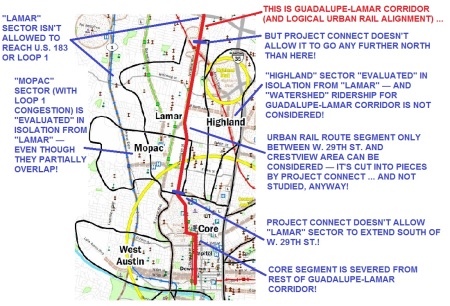
Project Connect Needs an Overhaul
7 December 2013
Lyndon Henry, technical consultant for Texas Association for Public Transportation, making presentation to CCAG on Dec. 6th. Screenshot from City of Austin video.
♦
By Lyndon Henry
These comments were presented to the December 6th meeting of the Central Corridor Advisory Group (CCAG), just prior to their voting 14-1 to approve the official recommendation (favoring the “Highland” and “ERC” sectors for so-called “high-capacity transit” — generally perceived as camouflage-speak for urban rail). Extemporaneous verbiage included during the oral presentation has been added to the version posted here.
To Central Corridor Advisory Group:
• Project Connect’s “High-Capacity Transit” study needs either to be paused and reviewed, or for Phase 2 to be expanded to include actual travel corridors in both the “Lamar” and “Mueller” sectors.
• The way this study was conducted has been shameful — an unprecedented rush in a context of pressure from political officials and special interests, ignoring actual travel corridors, gerrymandering city areas for study, cherry-picking data, manipulation of data, substituting value judgements for facts, public manipulation, muzzling community input, isolation from effective community review. However it may go forward, this process needs a major overhaul.
• Contradictory though it may seem, this does not mean I’m impugning the basic honesty or competency of the Project Connect team. While I do believe this study has been skewed, I continue to believe that the Project Connect personnel are fundamentally honest and competent. In my view, there’s a tragedy that good, decent, honest, competent professionals are influenced by external political pressures to make unwise decisions on crucial methodological and procedural issues.
• The problems in this study are way too numerous to detail here, so I’ll just note a few of the most outrageous.
• Project Connect’s methodology segmented the outstanding Guadalupe-Lamar corridor into nonsensical pieces, severing it from its most logical destination (the West Campus and core area), thus creating an arbitrary “rump” route that goes from nowhere to nowhere.

Infographic shows how Project Connect’s methodology segmented Guadalupe-Corridor into nonsensical pieces, and summarizes numerous other major problems. (Click to enlarge.)
• Extremely important non-work trips such as UT student trips and recreational trips have been EXCLUDED as a measure of “Travel Demand” from each sector to the core. How could they do this in a city whose core contains the largest university in the state?
• Rather than developing conservative, reliable, and plausible forecasts, Project Connect has produced exaggerated, highly questionable projections, heavily skewed toward certain geographical areas. When these same projections are plugged into Project Connect’s own Transit Orientation Index (TOI), the results are ridiculously unbelievable. For the single “ERC” sector, the low-end prediction of daily transit ridership is higher than the total system daily ridership of entire cities like Denver and Seattle. On the high end, it’s about equal to the total system daily ridership of Chicago and Philadelphia combined.
Do you really expect the Austin public at large to believe these kinds of results?
These shenanigans, and treatment of the community as if they were fools, have been a slap in the face to central Austin’s core neighborhoods, that have remained among urban rail’s strongest supporters, have been promised a rail line, and have spent many hours of time crafting neighborhood rail station plans.
Guadalupe-Lamar remains at the heart of the city, where all the core neighborhoods are, and where a Phase 1 urban rail line should start and provide a spine or anchor for outward extensions. And it provides both the demographics and the “opportunity assets” at the least cost for doing so.
I urge you to do the right thing and help to move this process in a very different direction.

[…] • Project Connect Needs an Overhaul […]